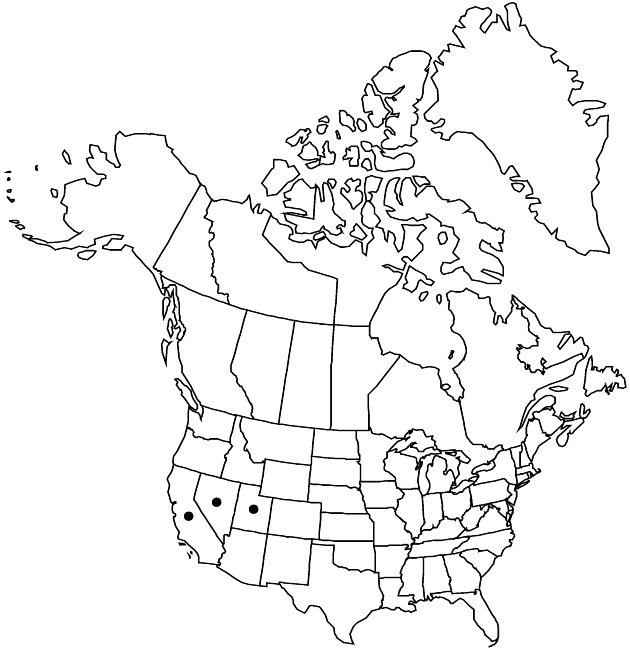Difference between revisions of "Erigeron clokeyi"
Brittonia 6: 214. 1947.
FNA>Volume Importer |
RevisionBot (talk | contribs) m (Bot: Adding category Revised Since Print) |
||
| (8 intermediate revisions by 3 users not shown) | |||
| Line 8: | Line 8: | ||
}} | }} | ||
|common_names=Clokey’s fleabane | |common_names=Clokey’s fleabane | ||
| + | |special_status={{Treatment/ID/Special_status | ||
| + | |code=E | ||
| + | |label=Endemic | ||
| + | }} | ||
|basionyms= | |basionyms= | ||
|synonyms= | |synonyms= | ||
| Line 20: | Line 24: | ||
-->{{Treatment/Body | -->{{Treatment/Body | ||
| − | |distribution= | + | |distribution=Calif.;Nev.;Utah |
|discussion=<p>Varieties 2 (2 in the flora).</p><!-- | |discussion=<p>Varieties 2 (2 in the flora).</p><!-- | ||
| − | --><p>Erigeron clockeyi is found in the Great Basin and Sierra Nevada.</p> | + | --><p><i>Erigeron</i> clockeyi is found in the Great Basin and Sierra <i>Nevada</i>.</p> |
|tables= | |tables= | ||
|references= | |references= | ||
| Line 45: | Line 49: | ||
-->{{#Taxon: | -->{{#Taxon: | ||
name=Erigeron clokeyi | name=Erigeron clokeyi | ||
| − | |||
|authority=Cronquist | |authority=Cronquist | ||
|rank=species | |rank=species | ||
| Line 52: | Line 55: | ||
|basionyms= | |basionyms= | ||
|family=Asteraceae | |family=Asteraceae | ||
| − | |distribution= | + | |distribution=Calif.;Nev.;Utah |
|reference=None | |reference=None | ||
|publication title=Brittonia | |publication title=Brittonia | ||
|publication year=1947 | |publication year=1947 | ||
| − | |special status= | + | |special status=Endemic |
| − | |source xml=https:// | + | |source xml=https://bitbucket.org/aafc-mbb/fna-data-curation/src/2e0870ddd59836b60bcf96646a41e87ea5a5943a/coarse_grained_fna_xml/V19-20-21/V20_613.xml |
|tribe=Asteraceae tribe Astereae | |tribe=Asteraceae tribe Astereae | ||
|genus=Erigeron | |genus=Erigeron | ||
| Line 63: | Line 66: | ||
}}<!-- | }}<!-- | ||
| − | -->[[Category:Treatment]][[Category:Erigeron]] | + | --> |
| + | |||
| + | [[Category:Treatment]] | ||
| + | [[Category:Erigeron]] | ||
| + | [[Category:Revised Since Print]] | ||
Latest revision as of 19:29, 6 November 2020
Perennials, 3–20(–30) cm; taprooted, caudices usually branched, retaining old leaf bases. Stems usually ascending to erect, moderately hirsute to hispidulous (hairs spreading-deflexed), minutely glandular at least distally. Leaves basal (persistent) and cauline (petioles prominently ciliate, hairs spreading, thick-based); basal blades 1–3-nerved, narrowly oblanceolate (often folding), 20–50(–80) × 1–5 mm, margins entire, faces strigose or hispidulous to hirsutulous, minutely glandular; cauline blades linear to linear-lanceolate, reduced distally to near heads. Heads 1(–2). Involucres 4–7 × 6–11 mm. Phyllaries in 2–3(–4) series (greenish), moderately hirsute, densely minutely glandular. Ray florets 20–40(–55); corollas blue, less commonly white to pink, 6–11 mm, laminae reflexing. Disc corollas 2.9–4.5 mm (throats tubular). Cypselae 1.8–2.5 mm, 2-nerved, faces sparsely strigose; pappi: outer of inconspicuous, fine setae, inner of (13–)20–27 bristles.
Distribution

Calif., Nev., Utah
Discussion
Varieties 2 (2 in the flora).
Erigeron clockeyi is found in the Great Basin and Sierra Nevada.
Selected References
None.
Key
| 1 | Leaves hirsuto-strigose (hairs basally ascending, otherwise straight, antrorsely appressed); cypselae 2.2–2.5 mm; Charleston Mountains, Clark County, Nevada | Erigeron clokeyi var. clokeyi |
| 1 | Leaves uniformly hispidulous to hirsutulous (hairs spreading to spreading-arching, stiff); cypselae 1.8–2 mm; California, c Nevada, wc Utah | Erigeron clokeyi var. pinzliae |